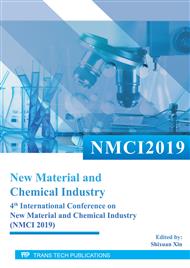[1]
W.H Wang. Research on properties and mechanism of rice husk ash concrete[D]. Ning Xia University Ph.D. thesis, 2017 (in Chinese).
Google Scholar
[2]
Y.X. SHE, J.Z. LI, M.B CAO, etc.Research of rice husk ash and application of rice husk ash in concrete [J]. Concrete, 2016, 37(6): 57-62 (in Chinese).
DOI: 10.25236/ajage.2022.040202
Google Scholar
[3]
S.K. Antiohos, V.G. Papadakis, S. Tsimas. Rice husk ash(RHA) effectiveness in cement and concrete as a function of reactive silica and fineness[J]. Cement and concrete research, 2014, 61:20-27.
DOI: 10.1016/j.cemconres.2014.04.001
Google Scholar
[4]
A.Gholizadeh Vayghan, A.R. Khaloo, F.Rajabipour. The effects of a hydrochoric acid pretreatment on the physicochemical properties and pozzolanic performance of rice husk ash[J]. Cement and concret composites, 2013, 39(5); 131-140.
DOI: 10.1016/j.cemconcomp.2013.03.022
Google Scholar
[5]
V. Saraswathy, H.W. Song, Corrosion performance of rice husk ash blended concrete, Construction Building Materials, 2007, 21:1779-1784.
DOI: 10.1016/j.conbuildmat.2006.05.037
Google Scholar
[6]
Q.G. Feng, H. YamamiCHi, M. Shoya, S. Sugita, Study on the pozzolanic properties of rice husk ash by hydroChloric acid pretreatment[J]. Cement and concrete research, 2004, 34: 521-526.
DOI: 10.1016/j.cemconres.2003.09.005
Google Scholar
[7]
K. Ganesan, K. Rajagopal, K.Thangavel. Rice husk ash blended cement: assessment of optimal level of replacement for strength and permeability properties of concrete[J]. Construction and building materials, 2008, 22:1675-1683..
DOI: 10.1016/j.conbuildmat.2007.06.011
Google Scholar
[8]
WAN Hui-wen, LIU Li, CHEN Wei. Study of self compacting concrete with rice husk ash[J].Journal of Wuhan university of technology, 2011, 33(7): 32-34.
Google Scholar
[9]
M.H. Zhang, R. Lastra, V.M. Malhotra, Rice-husk ash paste and concrete: some aspects of hydration and the microstructure of the interfacial zone between the aggregate and paste, Cement and concrete research, 1996,26:963-977.
DOI: 10.1016/0008-8846(96)00061-0
Google Scholar
[10]
Li Zhen-guo, ZHANG Ya-fen, WANG Xiao-peng, etc. Experimental investigation on properties of nano-SiO2/RHA/FA cement-based materials, 2013, 32(6):1017-1021(in Chinese).
Google Scholar
[11]
F. Tomosawa, T. NoguCHi, C. Hyeon, Simulation model for temperature rise and evolution of thermal stress in concrete based on kinetic hydration model of cement, in:S.C Handra (Ed.), Proceedings of Tenth International Congress Chemistry of Cement, Gothenburg, Sweden, vol. 4, 1997, pp.72-75.
Google Scholar
[12]
Park K B. Prediction of cracking in high strength concrete using a hydration model[D]. Tokyo: The University of Tokyo, (2001).
Google Scholar
[13]
Park K B, Jee N Y, Yoon I S, et al. Prediction of temperature distribution in high strength concrete using hydration model[J]. ACI Mater J., 2008, 105:180-186.
Google Scholar
[14]
B.H. Oh, S.W. CHa, Nolinear analysis of temperature and moisture distributions in early-age concrete structures based on degree of hydration, ACI Mater. J. 100 (2003) 361–370.
DOI: 10.14359/12811
Google Scholar
[15]
K. Maekawa, R. CHaube, T. Kishi, Modeling of Concrete Performance: Hydration, Microstructure Formation and Mass Transport, Routledge, London, UK, (1998).
Google Scholar
[16]
Q.J. Yu, K. Sawayama, S. Sugita, M. Shoya, Y. Isojima, The reaction between rice husk ash and Ca(OH)2 solution and the nature of its product[J]. Cement and concrete research, 1999, 29: 37-43.
DOI: 10.1016/s0008-8846(98)00172-0
Google Scholar
[17]
D.P. Bentz, V. Waller, F.D. Larrard, Prediction of adiabatic temperature rise in conventional and high-performance concretes using a 3-D microstructural model, Cement and concrete research, 1998, 28: 285-297.
DOI: 10.1016/s0008-8846(97)00264-0
Google Scholar
[18]
O.M. Jensen, P.F. Hansen, Water-entrained cement-based materials: I. Principles and theoretical background[J]. Cement and concrete research, 2001, 31: 647-654.
DOI: 10.1016/s0008-8846(01)00463-x
Google Scholar
[19]
V.T. Nguyen, Rice husk ash as a mineral admixture for ultra high performance concrete (Dissertation)[D]. Delft University of technology, (2011).
Google Scholar


